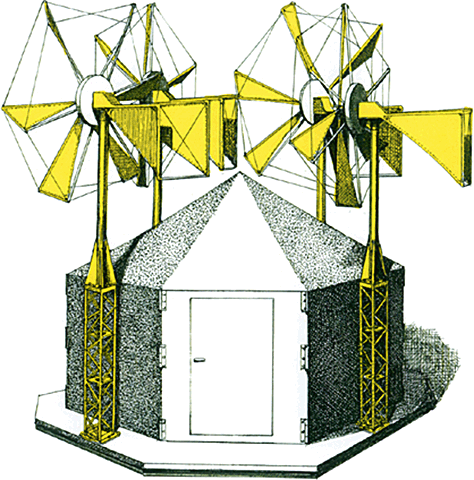
Susumu Shingu is a Japanese artist born in Osaka in 1937. He graduated from Tokyo University of Arts in 1960 in oil painting continuing his studies until 1962 at the Accademia di Belle Arti di Roma in Italy. Shingu showed his first three dimensional sculptures at the Galleria Blu (Milan) in 1966 and in the year after was awarded with the Ube Open-Air art museum prize at the 2 nd Contemporary Japanese sculpture show. He was a visiting artist at the Carpenter Center for the Visual Arts, Cambridge between 1971-72 and since than has continually exhibited his work in many international venues in Europe, America and Japan. In Massachusetts, Shingu also has works in the Logan Airport and in the New England Aquarium, Boston.
From 2000-2001 Susumu Shingu traveled around the world with his "Wind Caravan - Observation of our Planet' art project. It consisted in a wind caravan of 21 pieces of freestanding sculptures made with lightweight structure and sailcloth that interacted with the wind. The project aimed that the population of each place established, through artistic activities and cultural exchange, with local a close understanding and relation with their surrounding nature. The project visited six sites, as Brazil, New Zealand, Japan, Mongolia, Finland and Morocco and made scientific observations of wind energy at each site. The reports were conducted by Shingu himself and Dr. Izumi Ushiyama, an expert in wind energy. The reports are displayed on the Wind Caravan web page. In each site the artist developed several projects with the community, workshops and other cultural activities especially children.
As described by the artist himself:
I have devoted over 30 years of my life to create sculptures that move by wind or water. I think the richness and depth of natural energy helps keep me interested in creating new works with fresh ideas. It seems natural that I came to wish to find out more about our planet- the Earth, which is covered by air and circulates water. I came up with an idea to explore the places I have never been before with freestanding lightweight sculptures, which move by wind like a kite. Though I had no idea on such places nor knew how to select them. How and where I start such trip was totally unknown then.
It was May 1999 at Cafe Beaubourg when I first mentioned such dream over lunch with Pierre Restany, art critic, who is also one of my great friends. Mr. Restany earnestly listened to my dream and said, "This is a project only you can think of. Just forget about everything else and concentrate on this." And this conversation encouraged me to realize my dream. Mr. Jirí Kylián, a choreographer in Holland and his wife, Sabine, agreed with me and gave me a big hand. When I look around me, I see that I have so many precious friends who are very talented in their own right, like Renzo Piano, Tadao Ando (both architects), Issey Miyake(a designer), and Yusuke Nakahara(an art critic) and others. All of them showed interest in the Wind Caravan project and gave me an encouragement and even providing good ideas. Although the Wind Caravan began from my idea, from the beginning, it was strongly supported by many friends.
Site selection began with the process of sorting out the limited amount of knowledge and imagination I had on the Earth. The process of selecting sites was so dramatic that it would be worth writing a book just about it. It had the support of my friends from all over the world and experienced a number of interesting coincidences. Besides the rice field of Sanda-city in front of my studio, the other five sites are all new to me. They include native people from the indigenous culture found around each site, including Maori, Sami, and Berbère. I hope that we can learn from them how we can live without further destroying our natural environment. All these sites are known for strong wind but have no electricity. So they are suitable for research on natural energies of the Earth.
21 sculptures of two different designs are made of light-wight aluminum and sail cloth to receive the wind.Each sculpture will be approximately 5-meter high and weights only 75 kg and can be easily assembled and dismantled by manpower. The works will be packed in one 20 foot container while the crate will be reassembled into a small windmill house with four wind mills to generate energy at each site. Dr. Izumi Ushiyama, an expert on the wind energy, has been an advisor for windmills and is expecting that this will be a great opportunity to research wind energy.
The Wind Caravan will take place for two weeks at each. During this time my wife and I will stay at the site and will hold an activity with local children. Starting with traditional rice planting by local children in Japan and ending with special dance choreographed by Jirí Kylián to be danced by local children in Brazil. Children will keep participating in Wind Caravan throughout the exhibition period. We have visited the sites from last year through the beginning of this year and found local collaborators at each site. We have already started negotiations with them.
I do not intend to complete Wind Caravan as just a mere art event by an individual artist. I am hoping this process, going around the world with Wind Caravan, will make us think about the fure of the Earth. Real time reports will be dispatched and updated through Internet and other media. After it is complete, the project will be reported to the world through publishing, an exhibition, and TV programs.